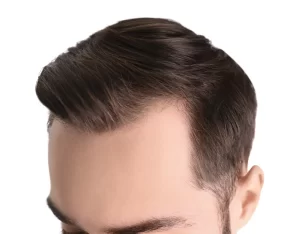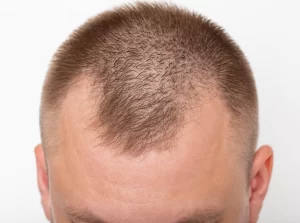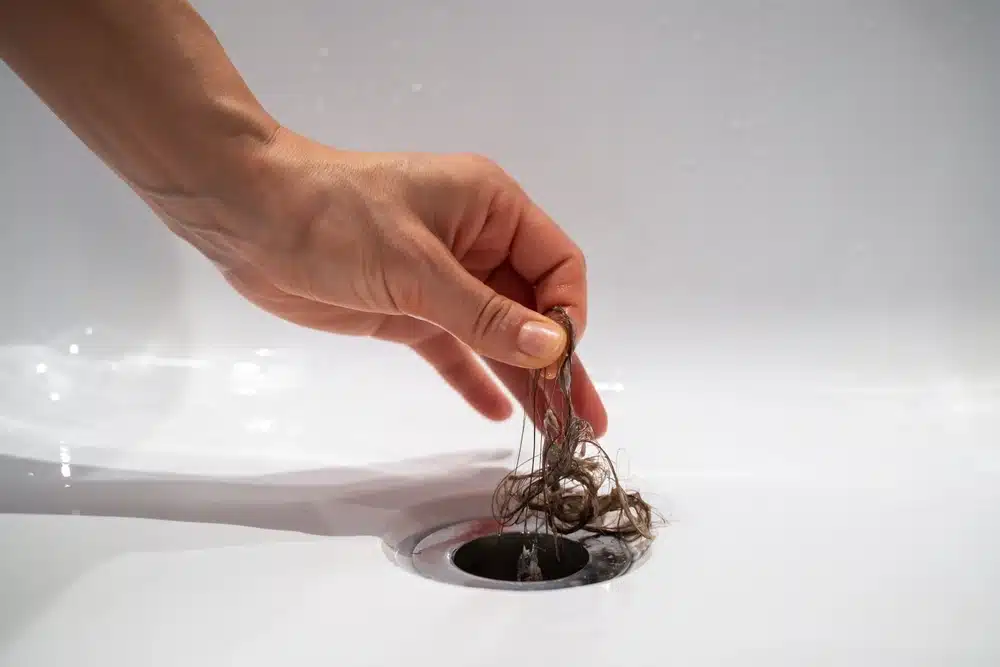Every person on the earth has their own individual traits that make them unique, and that includes different types of hairlines. Hairlines can even change with age, and what’s considered a good hairline can vary from person to person. If you’re interested in learning more about hairlines – and figuring out which one you have – this article is for you.
What Are the Different Types of Hairlines?
There are so many types of hairlines! From a widow’s peak to a bell-shaped hairline, learn all about them below.
A High Hairline
A high hairline is when the hair begins further up the scalp, which may make a person’s forehead seem a little bigger. This hairline is very common in both men and women. It’s usually caused by genetics – many people with a high hairline don’t experience hair loss alongside it; it’s just how their hair naturally grows.
A Low Hairline
A low hairline is when the hair grows further down the head. As a result, a much smaller distance between the hairline and the eyebrows gives the person a much smaller forehead. This one is considered a very good hairline for both men and women.
A Middle Hairline
The middle hair line is right in the middle of the low and high. It’s as it sounds – a hairline that isn’t too high or too low but somewhere in the middle. This is very common in women and is seen as one of the better hairlines to have.
Widow’s Peak
A widow’s peak creates a V shape in the middle of the forehead. It’s when there’s more hair coming down the centre and less at the sides. It’s different to a receding hairline – usually, there is much less hair loss or recession at the temples with a widow’s peak. A widow’s peak can be found in both men and women.
Triangular Hairline
A triangular/triangle hairline is the complete opposite of a widow’s peak. While a widow’s peak creates the shape of a V, the triangular hairline points upwards towards the hairline. While it is a normal hairline for many, it can also be caused by temporal triangular alopecia – a particular type of alopecia that affects only around 0.11% of the population. [3]
M-shaped Hairline
The M-shaped hairline is one of the most common types of hairlines in men. It can either be natural or caused by hair loss and is defined by more recession at the temples, which creates an M-shape. Those who experience an M-shaped hair line due to hair loss find that it recedes more as time passes.
Straight Lined Hairline
The straight hairline is when the hairline goes straight across the head without much or any receding visible. This hairline is seen as one of the best for men, as it looks youthful and healthy and has a head full of thick hair. Unfortunately, even those lucky enough to have a straight hairline find it doesn’t last forever, as male pattern baldness is very common!
Bell Shaped Hairline
A bell-shaped (or oval) hairline is very common in women. It’s a symmetrical shape that looks like an oval and is seen as one of the best hairlines.
An Uneven Hairline
An uneven hairline is asymmetrical, meaning it looks different on one side when compared to the other. Usually, the asymmetry isn’t too noticeable and isn’t anything to worry about.
A Receding Hairline
A receding hairline is defined as a hairline that starts receding over time. This commonly occurs in men (although it can affect women too). Most men experience at least a slightly receding hairline by the time they reach 50. It’s important to note there are different types of receding hairline, too – some men might recede more at the temples, whereas others might find they’re receding at the top.
What’s the Most Common Type of Hairline?
In men, one study showed that the most common type of hairline was the linear (straight) hairline and the M-shaped hairline. For women, the round hairline was the most common, accounting for 38.5% of participants. [1] Of course, this is only one study, but it gives some indication of the most common types of hairlines.
How to Figure Out Your Hairline
It’s pretty simple to see what type of hairline you have – you just need to look in a mirror. If you have longer hair, you may need to pull it back to see the hairline. Some people trace the hairline on the mirror to give a more definite view of which one they have. It might also be worth asking a friend if you’re still unsure!
What Affects the Type of Hairline You Have?
Generally, your hairline is affected by genetics, ageing, and your overall health. Your genetics determine the type of hairline you are born with, while ageing and health issues can change your hair line over time. For example, over 39% of men are completely bald in the UK [2] – something most aren’t born with!
What’s the Best Type of Hairline?
There is no absolute best type of hairline – everyone is different, and that’s okay! However, there are some hair lines that you might prefer to avoid. If your previous idea of a normal hairline was a straight hairline, but you start receding, you might want to do something to reverse that. After all, hair loss can harm your self-confidence.
In terms of what hair lines are overall considered to be good, they include the following:
- Low Hairline
- Straight Hairline
- Bell-shaped Hairline
- Middle Hairline
These are generally considered the best types of hairline. However, don’t worry – many other hairlines, like the Widow’s Peak, are also desirable!
Can You Change Your Hairline?
There are several ways to change your hairline – some involve simple adjustments, whereas others involve something a little more drastic like surgery.
- Changing Your Hairstyle
While changing your hairstyle won’t alter your hairline, it can change the way one appears. Certain hairstyles like curtain bangs can hide a high hairline, for example. For men, the slicked-back hairstyle works well for a receding M-shaped hairline.
- Using Hair Restoration Medications
Many men witness fantastic results after using hair-growing medications like finasteride and minoxidil. If you have a receding hairline, they are worth giving a go, as it might just help you regrow your hair. Keep in mind you need to keep using them forever for the results to stick around.
- Plucking
It might sound counterproductive to pluck a hairline (especially if you suffer from hair loss), but many people use this to straighten out an asymmetrical hairline. A FTM transgender person might even want to create a more masculine-looking hairline by plucking it. The good news is that the hair will grow back if you overpluck, but it’s best to be careful not to, as it will take a while (especially if you have long hair).
- Getting a Hair Transplant
The one real way to change your hairline is by getting a hair transplant. A FUE hair transplant uses individual grafts from one section of your hair and transplants it into the thinning or balding area, allowing new hair to grow there. You can get both a male and female hair transplant, and for many, it’s a massive confidence booster.
Why Would You Want to Change Your Hairline?
Most people who want to change their hairline have that desire because their hairline is receding. If they begin to lose their hair, they want to bring their hairline forward for a more youthful look.
Transgender people also commonly want to change their hairline. Hairlines look different in men and women, so a person transitioning may want to get a transgender hair transplant to feel more comfortable in their body.
Should You Get a Hair Transplant?
Investing in a hair transplant means investing in your looks and self-confidence. It’s a way to regrow your hair using the most natural method, especially when you choose the FUE transplant technique. After a hair transplant, you will begin to grow a full head of hair once more.
There are specific criteria you must meet to be a good candidate for a hair transplant. Being healthy and over 25 is a prerequisite, and there are other boxes you will need to tick. Your doctor will go over all of this during a consultation. At the end of a consultation, you’ll know whether a hair transplant is the correct route for your hair restoration journey.
Book a Consultation Today
Do you want a straighter hairline? Perhaps you’re sick of your M-shaped hairline receding more and more over the years. If that’s the case, book a consultation for a FUE hair transplant with us today. Our team comprises only the best surgeons and doctors in the game, and we use the most specialised equipment and techniques to produce outstanding results. If you have any questions, get in touch!
Sources:





